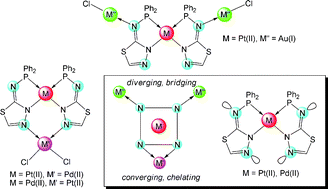The reaction of two equivalents of the functional ![[upper bond 1 start]](http://www.rsc.org/images/entities/char_e010.gif)
![[double bond, length as m-dash]](http://www.rsc.org/images/entities/char_e001.gif) NNCHS
NNCHS![[upper bond 1 end]](http://www.rsc.org/images/entities/char_e011.gif) (2) with [PdCl2(NCPh)2] in the presence of NEt3 gives the neutral, P,N-chelated complex cis-[Pd
(2) with [PdCl2(NCPh)2] in the presence of NEt3 gives the neutral, P,N-chelated complex cis-[Pd![[lower bond 1 start]](http://www.rsc.org/images/entities/char_e012.gif) (Ph2PN
(Ph2PN![[double bond, length as m-dash]](http://www.rsc.org/images/entities/char_e001.gif) C
C![[upper bond 1 start]](http://www.rsc.org/images/entities/char_e010.gif) N
N![[lower bond 1 end]](http://www.rsc.org/images/entities/char_e013.gif) N
N![[double bond, length as m-dash]](http://www.rsc.org/images/entities/char_e001.gif) CHS
CHS![[upper bond 1 end]](http://www.rsc.org/images/entities/char_e011.gif) )2] ([Pd(2−H)2], 3b), which is analogous to the Pt(II) analoguecis-[Pt
)2] ([Pd(2−H)2], 3b), which is analogous to the Pt(II) analoguecis-[Pt![[lower bond 1 start]](http://www.rsc.org/images/entities/char_e012.gif) (Ph2PN
(Ph2PN![[double bond, length as m-dash]](http://www.rsc.org/images/entities/char_e001.gif) C
C![[upper bond 1 start]](http://www.rsc.org/images/entities/char_e010.gif) N
N![[lower bond 1 end]](http://www.rsc.org/images/entities/char_e013.gif) N
N![[double bond, length as m-dash]](http://www.rsc.org/images/entities/char_e001.gif) CHS
CHS![[upper bond 1 end]](http://www.rsc.org/images/entities/char_e011.gif) )2] ([Pt(2−H)2], 3a) reported previously. These complexes function as chelating metalloligands when further coordinated to a metal through each of the CH-N atoms. In the resulting complexes, each endo-cyclic N donor of the thiadiazole rings is bonded to a different metal centre. Thus, the heterodinuclear
)2] ([Pt(2−H)2], 3a) reported previously. These complexes function as chelating metalloligands when further coordinated to a metal through each of the CH-N atoms. In the resulting complexes, each endo-cyclic N donor of the thiadiazole rings is bonded to a different metal centre. Thus, the heterodinuclear ![[lower bond 1 start]](http://www.rsc.org/images/entities/char_e012.gif) (Ph2PN
(Ph2PN![[double bond, length as m-dash]](http://www.rsc.org/images/entities/char_e001.gif) C
C![[upper bond 1 start]](http://www.rsc.org/images/entities/char_e010.gif) N
N![[lower bond 1 end]](http://www.rsc.org/images/entities/char_e013.gif) N
N![[lower bond 1 start]](http://www.rsc.org/images/entities/char_e012.gif)
![[double bond, length as m-dash]](http://www.rsc.org/images/entities/char_e001.gif) CHS
CHS![[upper bond 1 end]](http://www.rsc.org/images/entities/char_e011.gif) )2Pd
)2Pd![[lower bond 1 end]](http://www.rsc.org/images/entities/char_e013.gif) Cl2] ([Pt(2−H)2·PdCl2], 4a) and cis-[Pd
Cl2] ([Pt(2−H)2·PdCl2], 4a) and cis-[Pd![[lower bond 1 start]](http://www.rsc.org/images/entities/char_e012.gif) (Ph2PN
(Ph2PN![[double bond, length as m-dash]](http://www.rsc.org/images/entities/char_e001.gif) C
C![[upper bond 1 start]](http://www.rsc.org/images/entities/char_e010.gif) N
N![[lower bond 1 end]](http://www.rsc.org/images/entities/char_e013.gif) N
N![[lower bond 1 start]](http://www.rsc.org/images/entities/char_e012.gif)
![[double bond, length as m-dash]](http://www.rsc.org/images/entities/char_e001.gif) CHS
CHS![[upper bond 1 end]](http://www.rsc.org/images/entities/char_e011.gif) )2Pt
)2Pt![[lower bond 1 end]](http://www.rsc.org/images/entities/char_e013.gif) Cl2] ([Pd(2−H)2·PtCl2], 4b) were obtained by reaction with [PdCl2(NCPh)2] and [PtCl2(NCPh)2], respectively. In contrast, reaction of 3a with [AuCl(tht)] occurred instead at the P-bound N atom, and afforded the platinum/digold complex cis-[Pt
Cl2] ([Pd(2−H)2·PtCl2], 4b) were obtained by reaction with [PdCl2(NCPh)2] and [PtCl2(NCPh)2], respectively. In contrast, reaction of 3a with [AuCl(tht)] occurred instead at the P-bound N atom, and afforded the platinum/digold complex cis-[Pt![[lower bond 1 start]](http://www.rsc.org/images/entities/char_e012.gif) {Ph2PN(AuCl)
{Ph2PN(AuCl)![[double bond, length as m-dash]](http://www.rsc.org/images/entities/char_e001.gif) C
C![[upper bond 1 start]](http://www.rsc.org/images/entities/char_e010.gif) N
N![[lower bond 1 end]](http://www.rsc.org/images/entities/char_e013.gif) N
N![[double bond, length as m-dash]](http://www.rsc.org/images/entities/char_e001.gif) CHS
CHS![[upper bond 1 end]](http://www.rsc.org/images/entities/char_e011.gif) }2] ([Pt(2−H)2(AuCl)2], 5). For comparison, reaction of 4a with HBF4 yielded cis-[P
}2] ([Pt(2−H)2(AuCl)2], 5). For comparison, reaction of 4a with HBF4 yielded cis-[P![[lower bond 1 start]](http://www.rsc.org/images/entities/char_e012.gif) t(Ph2PNH
t(Ph2PNH![[double bond, length as m-dash]](http://www.rsc.org/images/entities/char_e001.gif)
![[upper bond 1 start]](http://www.rsc.org/images/entities/char_e010.gif) CN
CN![[lower bond 1 end]](http://www.rsc.org/images/entities/char_e013.gif) N
N![[lower bond 1 start]](http://www.rsc.org/images/entities/char_e012.gif)
![[double bond, length as m-dash]](http://www.rsc.org/images/entities/char_e001.gif) CHS
CHS![[upper bond 1 end]](http://www.rsc.org/images/entities/char_e011.gif) )2Pd
)2Pd![[lower bond 1 end]](http://www.rsc.org/images/entities/char_e013.gif) Cl2](BF4)2 ([H24a](BF4)2, 6), in which the chelated PdCl2 moiety is retained. Complexes 3b, 4a·CH2Cl2, 4b·0.5C7H8, 5·4CHCl3 and 6 have been structurally characterized by
Cl2](BF4)2 ([H24a](BF4)2, 6), in which the chelated PdCl2 moiety is retained. Complexes 3b, 4a·CH2Cl2, 4b·0.5C7H8, 5·4CHCl3 and 6 have been structurally characterized by

